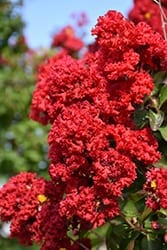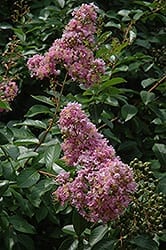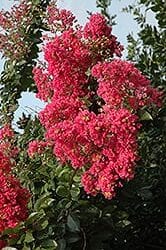Years ago, Crape Myrtle trees could only be enjoyed by our neighbors in the south. They were not hardy enough to live through our cold winter months and instead thrived only in warmer climates like North Carolina. Luckily many of those southern varieties have been cross-bred with hardier types, making crape myrtles more accessible to areas of the Northeast. Long Islanders can now enjoy growing a variety of these hardy crape myrtle hybrids.
This beautiful tree offers lilac-like flowers in pink, red, purple and white from July to September. Depending on the variety, they can grow anywhere from 5’ all the way up to 25-30’ and make a great specimen plant in the yard or even a nice hedge. Easy to grow and maintain, crapes have become one of Long Island’s most popular tree in the past 5-10 years.
Crape Myrtle trees have another awesome feature which is often overlooked, their bark. When they are not in bloom or in the dead of winter, specimens will exhibit a variety of colors and patterns from green to brown to grey on multiple stems. Some even have a peeling bark look which is a real showstopper in the landscape. If you are looking for a tree with year round interest and long-lasting flowers, this tree is a must have.
Crape Myrtles are also easy to plant, grow and care for. When planting, be sure to mix your existing soil with plenty of rich compost to give it the nutrients it needs to flourish. Each year you can top dress the area with additional compost or use an organic tree fertilizer like the Dr. Earth tree and shrub blend to keep nutrients high from year to year. Make sure you keep the soil around the tree well-watered during the first year until the plant establishes itself.
Pruning is also a piece of cake. You have the option to just let the tree go which will produce rigid branching that will give a full, upright form or you can prune it back to the large leader stems. The later method will allow it to grow a few feet on each branch and the heavy blooms will weigh down the fresh, new growth to give you more of a weeping habit. Either way, it will make for a beautiful addition to any garden or landscape.
Easy to grow, tons of color, year round interest, almost zero maintenance and no serious pests or diseases make crape myrtle the hottest plant for summer!
Here are a few of favorites:
Tuscarora: Upright large shrub or small tree with showy dark pink flowers all summer. Peeling and colorful bark really adds to its appeal. Mature size: 20-25 ft. tall.
Dynamite: Large multi-stemmed plant with beautiful crimson buds that open and turn cherry red in the summer. New leaves emerge crimson then turn dark green. Vigorous grower to 15 ft. tall.
Muskogee: Panicles of light lavender-pink flowers appear amid glossy green foliage that turns red in the fall. The cinnamon-colored bark is smooth, peeling to a shiny light gray. Moderate grower to 15 ft. tall.
Coral Magic: A shrub form crape myrtle with lovely salmon-pink flowers. Outstanding reddish new growth turns a brilliant green. Moderate grower 6-10 ft. tall.
Try a crape myrtle in your garden – you won’t be disappointed!






